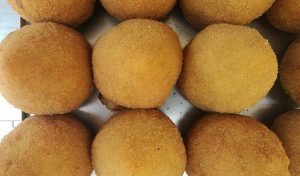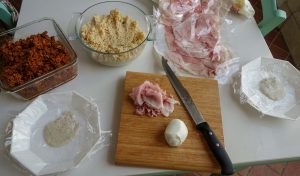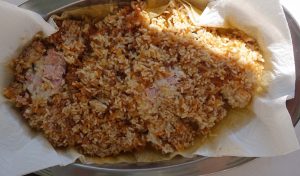Breadcrumb-coated balls of rice stuffed with ragu or ham and cheese, fried and presented as perfect balls of crispy, ricey, squidgy deliciousness; if you like all those ingredients, what’s not to love? I had orange and basil risotto leftovers, ragu leftovers, tasty fresh ham and mozzarella and the night before’s bread made into breadcrumbs. It never occurred to me that combining all that with merely a few other basic ingredients would result in anything other than perfectly formed arancini.
I blame the flour situation. The flour in our AirBnB kitchen, never opened and within date, had become a home for moths (bleugh) so I couldn’t use that. The recipe’s alternative flour suggestion of cornflour, I think, meant ground corn not soft, thickening cornflour, but as a plan B for bechamel sauce, it being lunch time in Italy so food shops closed, I decided to persevere with the cornflour, knowing deep down that abandonment was the best plan B. But, hey, what could go wrong when all the other ingredients were poised and ready to be arancini-ed …
When I have made my variation of arancini before, I just rolled the stuffed rice ball in a bit of whisked egg and dipped it in breadcrumbs; sloppy leftovers solution. A semblance of a “little orange” shape in maybe one in three balls post-frying had always been sufficient reward. This time, being in Sicily, following a proper recipe for arancini and having good quality key ingredients, I really did expect perfection for every single rice ball.
In short, if you do not have the right flour or a realistic substitute, don’t bother with bechamel sauce (I hadn’t even known that proper arancini had bechamel sauce). Also, the absence of proper flour means you can’t make a batter with which to seal the balls and provide glue for the breadcrumbs (and we didn’t have eggs). My determination to have arancini for lunch that day was my downfall. It was too depressing to photograph but the cornflour bechamel sauce was exemplary culinary failure and contributed a good 20 minutes to the delay of lunch. You can see from the photograph that I only managed to salvage (creating a lot of gluey, gunky mess in the process, especially where a sieve was concerned) a small amount of sauce.
Looking online, there seem to be a lot of different ways to make arancini, but I’m going to one day try again with the Katie and Giancarlo Caldesi recipe I tried in Sicily – Recipes from an Italian island as I enjoyed all the recipes I followed from their book while in Sicily. I have halved the ingredients because I made this based on their recipes for ragu and orange and basil risotto, which gave leftovers of roughly half. The method I have used is not directly copied from theirs and factors in leftover risotto and ragu rather than making everything from scratch. I realise now why I so rarely think to try to make arancini. I don’t make risotto or ragu often so it’s unheard of to have both as leftovers at the same time, though ham and cheese for all arancini is hardly a bad thing, especially if you make the effort to make bechamel sauce too, and it falls into a faff category that I’m not often in the mood for. It’s worth it though, even my giant, mushy dollop of “arancini” tasted good.

Arancini
(makes about 6 arancini)
Risotto
leftover risotto (it needs to have been made with arborio or carnaroli rice, this particular “leftover risotto” factoring in a risotto recipe with 300g of dried rice to serve four people, probably half of it already eaten by two people the day before)
Bechamel
(half for the ragu balls, half for the ham and cheese)
200 ml whole milk
1 bay leaf
40g salted butter
30g ’00’ flour
salt and freshly ground black pepper
pinch of ground nutmeg
Mozzarella and ham filling
75g cooked ham, finely chopped
60g mozzarella, finely chopped
10g Parmesan, finely grated
(40g cooked peas – I ignored this, I just wanted ham and cheese)
Ragu filling
125g (ish) of beef ragu leftover
Coating
50g ’00’ flour
75ml tepid water
50g breadcrumbs (try a hand blender to shred some leftover bread)
-Method-
(Bechamel sauce)
Add the milk and bay leaf to a saucepan, warm over a medium heat.
In another saucepan, warm the butter and flour, stirring continuously.
As soon as the flour mixture is bubbling a little in the pan, pour the hot milk over the flour and immediately start whisking, keeping the pan on a low heat.
When the mix starts looking more like a sauce than a clotted mess, add salt, pepper and nutmeg. Keep stirring regularly until the sauce thickens.
Once thickened to a dollopy consistency, remove the pan from the heat and scrape out the sauce evenly between two bowls (assuming you’re making ragu AND ham and cheese fillings). Then coat the sauce in cling film, ie so the film is touching the sauce, and allow to cool.

Add the flour and water to a bowl big/deep enough to later incorporate a rice ball, then use a whisk or stick blender to make the flour and water combination smooth.
Put the breadcrumbs in another bowl with ample room to roll each rice ball in.
Dip your hands in cold water and work the leftover risotto through your hands so it has a more cohesive consistency (for up to about five minutes).
Either weigh out c120g of risotto or place a pat of it on the palm of your hand, about 1cm thick and push it to form a large circle in the palm of your hand and covering most of your fingers. Cup your hand, making the rice into a kind of bowl, and add a good tablespoon or so of the filling. Wrap the risotto rice around the filling, adding more, squeezing and pushing until you can’t see any of the filling through the rice, then roll in your hands until you have your “small orange” rice ball.
Dip your ball of ricey perfection into the batter, let the batter excess drip off, then roll the ball in the breadcrumbs to cover, pushing more crumbs into rogue bald patches, then place on a plate (if you’re confident they’ll retain their shape and coating) or straight into hot oil.
To fry, heat the oil in a deep-sided saucepan (or deep fat fryer) to around 175c. If the arancini are completely submerged in oil, they should be a lovely golden brown within 5-7 minutes. If your oil isn’t deep enough, turn them over once one half is golden brown.
Test they are hot throughout by piercing a skewer through to the middle of the rice ball. If the skewer comes out hot, they’re cooked and ready to eat. If the skewer comes out merely warm, put the ball back in the oil.
Drain each ball (or the entire mush if yours turned out like mine) on kitchen paper and admire and rejoice in the shape of your arancini if they’ve made it out whole and rounded.

